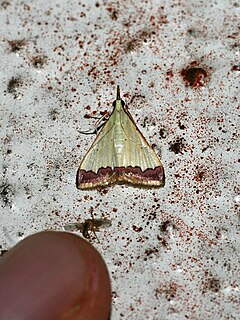
Autocharis is a genus of moths of the family Crambidae.
Hyperlais conspersalis is a species of moth in the family Crambidae described by Wolfram Mey in 20111. It is found in Namibia.
Hyperlais transversalis is a species of moth in the family Crambidae described by Wolfram Mey in 2011. It is found in Namibia.
Namibicola palmwagos is a species of snout moth in the genus Namibicola. It was described by Wolfram Mey in 2011, and is known from Namibia and South Africa.
Autocharis librodalis is a species of moth of the family Crambidae described by Pierre Viette in 1958. It is found in Madagascar.
Eoophyla excentrica is a moth in the family Crambidae. It was described by Wolfram Mey and Wolfgang Speidel in 1999. It is found in Yemen, Saudi Arabia, Ethiopia, Kenya, Tanzania and Uganda.
Eoophyla assegaia is a moth in the family Crambidae. It was described by Wolfram Mey in 2011. It is found in South Africa.
Tegostoma aridalis is a moth in the family Crambidae. It was described by Wolfram Mey in 2011. It is found in Namibia and South Africa.
Crambicybalomia is a monotypic moth genus of the family Crambidae and subfamily Cybalomiinae. Its only species, Crambicybalomia ariditalis, is found in Namibia and South Africa. Both the genus and species were first described by Wolfram Mey in 2011
Achyra arida is a moth in the family Crambidae. It was described by Koen V. N. Maes in 2005. It is found in Kenya.
Autocharis albiplaga is a moth in the family Crambidae. It was described by George Hampson in 1913. It is found in South Africa.
Autocharis barbieri is a moth in the family Crambidae. It was described by Henry Legrand in 1966. It is found on the Seychelles, where it has been recorded from Aldabra.
Autocharis bekilalis is a moth in the family Crambidae. It was described by Hubert Marion and Pierre Viette in 1956. It is found on Madagascar.
Autocharis discalis is a moth in the family Crambidae. It was described by Jay C. Shaffer and Eugene G. Munroe in 2007. It is found on the Seychelles, where it has been recorded from Aldabra.
Autocharis ecthaemata is a moth in the family Crambidae. It was described by George Hampson in 1913. It is found in Ethiopia, Kenya, Madagascar and on Aldabra atoll in the Seychelles.

Autocharis fessalis is a moth in the family Crambidae. It was described by Charles Swinhoe in 1886. It is found in the Democratic Republic of the Congo, on the Seychelles and in South Africa, the United Arab Emirates, Yemen, Bhutan, India and Pakistan.
Autocharis jacobsalis is a moth in the family Crambidae. It was described by Hubert Marion and Pierre Viette in 1956. It is found in Madagascar and South Africa.
Autocharis linealis is a moth in the family Crambidae. It was described by Jay C. Shaffer and Eugene G. Munroe in 2007. It is found on the Seychelles, where it has been recorded from Aldabra.
Ephelis maesi is a moth in the family Crambidae. It was described by Wolfram Mey in 2011. It is found in Namibia, South Africa and Zimbabwe.
Metasia grootbergensis is a moth in the family Crambidae. It was described by Wolfram Mey in 2011. It is found in Namibia.

